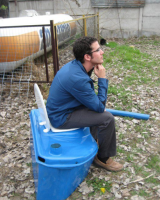- Forum
- categories
- Sanitation systems
- Faecal sludge management (FSM)
- Determining helminth egg quantities (measurement techniques)
- Wanting a better way to test pathogen inactivation? Us too! Can you help me crowdsource a better way?
Wanting a better way to test pathogen inactivation? Us too! Can you help me crowdsource a better way?
46.4k views
Re: Wanting a better way to test pathogen inactivation? Us too! Can you help me crowdsource a better way?
(or most off the shelf microscopic lens attachments for mobile-phones)
And maybe one could even train a clever image recognition algorithm to pre-highlight potential eggs in the viewing app.
The main issue I see it to come up with a easy and less labor & time consuming procedure to concentrate the eggs.
A system to artificially spike sludge with canine ascari eggs prior to a treatment would probably need to be included too.
I saw on the sanivation site that you have an upcoming trial on this soon? Please keep us informed!
Please Log in to join the conversation.
You need to login to reply- PatrickBBB
-

- Water and environment engineer.
Less- Posts: 14
- Karma: 3
- Likes received: 7
Re: Wanting a better way to test pathogen inactivation? Us too! Can you help me crowdsource a better way?
as far as I know this technology is meant to test drinking water sources and not effluent from sanitation systems. Of course it is possible still to use this for sanitation systems, but while E.coli is a good indicator organism (proving fecal contamination) it is a bad way to assess the performance of a sanitation system.
With that said, we should rather look at low cost, easy-to-use approaches like the one mWater is promoting rather than something similar to Del Agua. Providing technology and methodology that is viable for the user himself (or a local community sanitation volunteer) to use is the way for sustainable monitoring.
Attaching a guide made by UN-Habitat for more details on the approach mWater is promoting.
Regarding a better way to test pathogen inactivation:
I would like to again stress on the importance of an low-cost and easy-to-use technology as pointed out by both Canaday and Turner. In my opinion, this monitoring should be conducted by the user itself or by local community groups.
As for a microscope, it might be viable in some situations, where knowledge of how to use it is available, but as I said I would rather see a technology that is cheap and requires little training.
Raman spectroscopy seems quite interesting, but I am a bit skeptical to the scenario that you envision Joe. I would think the environment in which the test is to be conducted has to be quite stable to have a reliable output which can be interpreted. The level of sophistication in this technology is not something that I think can fit into a handheld gadget, at least not for a long time.
It does though remind me of
- it also uses light scattering.
This message has an attachment file.
Please log in or register to see it.
Please Log in to join the conversation.
You need to login to reply- ben
-

- Water and sanitation engineer
Less- Posts: 107
- Karma: 11
- Likes received: 57
Re: Wanting a better way to test pathogen inactivation? Us too! Can you help me crowdsource a better way?
Just to share this apps mWater, which isn't detailed at all on the website ... anyone heard some more about ? play.google.com/store/apps/details?id=co.mwater.clientapp
Article from the last Sandec News (07/2013) :
Android App to Count E. Coli
New enzyme-based tests for indicator bacte- ria are changing the way microbial water quality monitoring can be done. Sandec has partnered with the non- profit tech startup, mWater, to develop an An- droid app with which cellphone cameras can count E. coli and total coliform colonies on one such product, the Nissui Compact Dry EC plates. An automatic counter can reduce user error and simplify sample processing, especially when large numbers of samples must be analyzed. The mWater app already includes a colony counter for a similar testing product (3M Petrifilm), along with Sanitary Inspection forms and GPS functions. It requires a 5 MP autofocus camera for best results and is a free download in the Google Play store at: play.google.com/store/apps/ details?id=co.mwater.clientapp
Wishing you a good day,
Ben
Please Log in to join the conversation.
You need to login to reply- joeturner
-
 Less
Less- Posts: 717
- Karma: 23
- Likes received: 185
Re: Wanting a better way to test pathogen inactivation? Us too! Can you help me crowdsource a better way?
canaday wrote: Hi Andrew and Joe,
Very important topic that needs to be fine-tuned.
Joe, I had a look at the article on Raman Spectroscopy in Wikipedia and I did not see how this could search for an Ascaris egg in a pile of dirt. Please enlighten us on this.
en.wikipedia.org/wiki/Raman_spectroscopy
Hi Chris - I was offering this as a possible 'ideal' solution rather than anything which could be implimented soon.
The public laboratory have been working on producing a very low cost desktop spectrometry system, see here: store.publiclab.org/products/desktop-spectrometry-kit
Raman spectrometry is, apparently, possible using low-tech pointers see here optics.org/news/3/10/15
And microbiologists are investigating the use of raman spectrometry in identifying microbes in samples, see for example here www.ncbi.nlm.nih.gov/pubmed/21958140
Of course, you are right that this is all speculation - but if we're talking about what we'd like to see, then being able to use a cup of faeces, shaking it up in water and shining a hand-held and low-cost scientific gadget into it to determine the presence or absence of seems to me to be hard to beat. I repeat that I don't have the skills to put these things together - just remarking that it'd be great if it was possible.
I suggest we work out a protocol that does not require anything specialized or expensive beyond a microscope (which is extremely hard to do without). This may involve washing a large sample of treated feces (say a kilogram) with something like a saturated salt solution, straining it through a mesh into a 3-liter Coke bottle, and allowing the Ascaris eggs to float to the top overnight and stick to the microscope slide placed on the mouth of the bottle. A quick examination of the slide under the microscope the next day should give a fairly definitive answer to the question of whether or not there are Ascaris eggs in the sample. This is based on a WHO document cited in the following post, only taken to a bigger scale to have a more definitive answer with less microscopy:
forum.susana.org/forum/categories/34-uri...slum-sanitation#2495.
I remember when we discussed this before that we were told that the protocol is not as simple as just presence or absence of ascaris, because it can be present but not active. Personally I'm not sure that this is the way to go as it seems to require significant input from highly trained microbiologists.
In my view, some kind of mechanised test (perhaps using a simple DNA based dye test or something) is ideally what we want.
I also suggest that small envelopes of plastic mesh containing feces known to have Ascaris could be dropped periodically into UDDTs, for analysis at the end of the process. This would reduce or eliminate the need to concentrate the Ascaris eggs.
I agree, spiking of samples with Ascaris (or other index pathogen) seems like a very good idea. Some samples might have none present at the end of the process simply because there was none there in the first place. Good point Chris, I hadn't thought of that.
Please Log in to join the conversation.
You need to login to replyRe: Wanting a better way to test pathogen inactivation? Us too! Can you help me crowdsource a better way?
Very important topic that needs to be fine-tuned.
Joe, I had a look at the article on Raman Spectroscopy in Wikipedia and I did not see how this could search for an Ascaris egg in a pile of dirt. Please enlighten us on this.
en.wikipedia.org/wiki/Raman_spectroscopy
I agree that Ascaris is the organism to look for, since there seems to be a good consensus this is the most resistant of all fecal pathogens AND we can actually see it and identify it with a microscope. (Andrew, I understand why you had to use the canine helminth Toxocara in your study in Chile, as almost no one had Ascaris, but it is better to work on the actual human parasite (Ascaris).)
I suggest we work out a protocol that does not require anything specialized or expensive beyond a microscope (which is extremely hard to do without). This may involve washing a large sample of treated feces (say a kilogram) with something like a saturated salt solution, straining it through a mesh into a 3-liter Coke bottle, and allowing the Ascaris eggs to float to the top overnight and stick to the microscope slide placed on the mouth of the bottle. A quick examination of the slide under the microscope the next day should give a fairly definitive answer to the question of whether or not there are Ascaris eggs in the sample. This is based on a WHO document cited in the following post, only taken to a bigger scale to have a more definitive answer with less microscopy:
forum.susana.org/forum/categories/34-uri...slum-sanitation#2495.
I also suggest that small envelopes of plastic mesh containing feces known to have Ascaris could be dropped periodically into UDDTs, for analysis at the end of the process. This would reduce or eliminate the need to concentrate the Ascaris eggs.
Anyone looking for a thesis?
Best wishes,
Chris Canaday
Omaere Ethnobotanical Park
Puyo, Pastaza, Ecuador, South America
inodoroseco.blogspot.com
Please Log in to join the conversation.
You need to login to reply- joeturner
-
 Less
Less- Posts: 717
- Karma: 23
- Likes received: 185
Re: Wanting a better way to test pathogen inactivation? Us too! Can you help me crowdsource a better way?
log reductions are not the way to you as what you really want to know is whether the remaining levels of pathogens are safe, not how many you've managed to destroy.
In my view, the only way to do the above is with a Quantitative Microbiological Risk Assessment (QMRA) using a Monte Carlo simulation - we have discussed this before on this forum.
Once the above analysis has been done and a baseline 'safe' exposure has been calculated, I think what is then needed is a rapid system to analyse whether the treatment has met the standard or not.
Personally I think the price-point is another critical factor. All systems need to be tested regularly, preferably on a batch-testing regime. So I think $1000 is far too high.
In an ideal world, $1000 would be the cost to establish safe dose levels from reference pathogens of particular sanitation technologies in particular places, then the actual testing of samples would be as near to $0 as possible. I would see this as a validation mechanism using known microbiological techniques followed by some kind of instantaneous scanning electrical device to establish the presence/absence of the model pathogen, most likely ascaris helminths. I read once that there was work on building low cost hand-held Raman Spectroscopy unitss - which is currently under investigation by microbiologists as a way to identify microbes - which sounds to me like it would tick all the boxes.
I am not offering to do any of this, sadly I am not an engineer or a microbiologist. But that's the direction I would be looking in.
Please Log in to join the conversation.
You need to login to reply- AFoote
-
 Topic Author
Topic Author- Innovating sanitation solutions to meet demand from BOP
Less- Posts: 16
- Karma: 3
- Likes received: 8
Wanting a better way to test pathogen inactivation? Us too! Can you help me crowdsource a better way?
For awhile now I've been a bit frustrated by how difficult it is to understand if treatment solutions are being effective. As far as I know, there is no real quick test on how to tell if something is working or if it's quick it is very expensive. I am a strong believer that having good measurement and quick monitoring is crucial for innovation and system sustainability. Is anyone already using a system or know of one out there?
I think as a SunSanA community we can come up with a better way to test pathogens reduction. I'd love to see us develop something like the Del Agua but for sanitation systems ( )
I've put together and update on how Sanivation is starting to address this issue and I'd love your input! See: sanivation.com/our-projects/mobile-pathogen-kit/
Some of the initial questions we are debating are:
- What pathogens should we test? Right now we are planning on a kit for helminth and E.coli
- What should be the price point? Right now we are thinking under $1,000
- What is the right mix of precision and labor required? Right now we are wanting to be able to do log reductions
What do you think? Please reply to this topic as a way to share ideas and to collaborate on designing a kit that meets all of our needs.
Very excited about this project!
Andrew
Co-founder
www.sanivation.com
Please Log in to join the conversation.
You need to login to reply- Forum
- categories
- Sanitation systems
- Faecal sludge management (FSM)
- Determining helminth egg quantities (measurement techniques)
- Wanting a better way to test pathogen inactivation? Us too! Can you help me crowdsource a better way?









